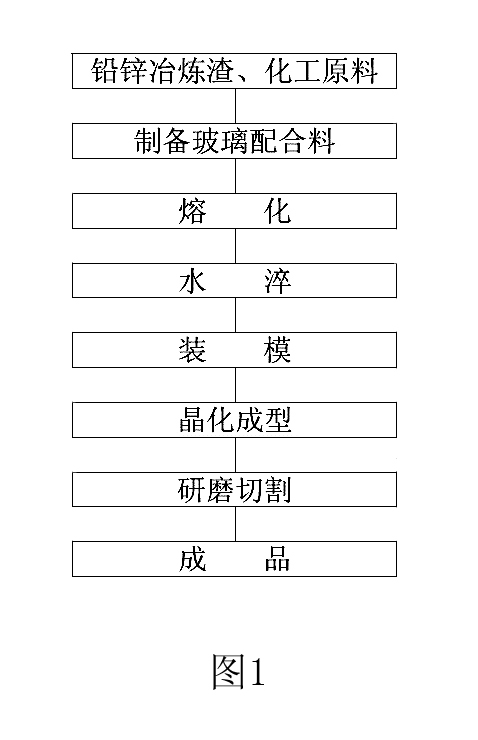Black microlite manufactured by using lead and zinc smelting dreg and manufacturing method thereof
A manufacturing method and smelting slag technology, applied in the direction of solid waste removal, etc., can solve the problems of high melting temperature and high cost of raw materials, and achieve the effects of increasing melting speed, reducing energy consumption, and improving efficiency
- Summary
- Abstract
- Description
- Claims
- Application Information
AI Technical Summary
Problems solved by technology
Method used
Image
Examples
Embodiment 1
[0045] Embodiment 1: Glass batch is made by weighing and mixing. The composition (weight) of the glass batch is: 60 parts of lead-zinc smelting slag, 21 parts of quartz, 20 parts of limestone, 3.6 parts of soda ash, 3.5 parts of zinc oxide, carbonic acid 3.7 parts of barium, 2 parts of iron oxide, 0.5 parts of manganese dioxide, and 0.2 parts of nickel oxide.
[0046] The composition and mass percentage content of the lead-zinc smelting slag used are: SiO 2 40.20%, AL 2 o 3 13.60%, CaO19.84%, MgO3.31%, K 2 O+Na 2 O1.93%, Fe 2 o 39.66%, ZnO0.71%, PbO0.06%.
[0047] Put the above-mentioned glass batch material in a mullite crucible and melt it in a box-type electric furnace at a temperature of 1480°C for 2 hours. After the melting is completed, pour the glass liquid into water to become glass pellets. 500 grams of glass granules were spread flat in a refractory mold with a size of 100×100 mm and crystallized in a box-type electric furnace at a crystallization temperature ...
Embodiment 2
[0048] Example 2: A glass batch is made by weighing and mixing. The composition (weight) of the glass batch is: 50 parts of lead-zinc smelting slag, 25 parts of quartz, 23 parts of limestone, 4 parts of soda ash, 4 parts of zinc oxide, carbonic acid 5 parts of barium, 5.2 parts of iron oxide.
[0049] The composition and mass percentage of the lead-zinc smelting slag used are the same as in Example 1.
[0050] The above-mentioned glass batch materials were melted in a glass tank furnace at a temperature of 1480°C for 2 hours, and after the melting was completed, the molten glass was directly poured into water to become glass pellets. Spread 26 kg of glass pellets in a refractory mold with a size of 6000×9000 mm and crystallize in a shuttle kiln fueled by liquefied petroleum gas at a crystallization temperature of 1050°C. Thus, a black microcrystalline stone product of 600×900×18 mm can be obtained.
Embodiment 3
[0051] Example 3: A glass batch is prepared by weighing and mixing. The composition (weight) of the glass batch is: 40 parts of lead-zinc smelting slag, 35 parts of quartz, 27 parts of limestone, 3.5 parts of soda ash, 2 parts of zinc oxide, carbonic acid 3 parts of barium, 2.2 parts of iron oxide, 0.05 part of cobalt oxide, and 0.2 part of nickel oxide. The color of the product is black.
[0052] The composition and mass percentage of the lead-zinc smelting slag used are the same as in Example 1.
[0053] The above-mentioned glass batch materials were melted in a glass tank furnace with a temperature of 1480° C. for 2 hours, and after the melting was completed, the molten glass was directly flowed into water to become glass pellets. 26 kg of glass granules were spread flat in a refractory mold with a size of 6000×9000 mm and crystallized in a shuttle kiln fueled by liquefied petroleum gas, with a crystallization temperature of 1060°C. Thus, a black microcrystalline stone p...
PUM
 Login to View More
Login to View More Abstract
Description
Claims
Application Information
 Login to View More
Login to View More - R&D
- Intellectual Property
- Life Sciences
- Materials
- Tech Scout
- Unparalleled Data Quality
- Higher Quality Content
- 60% Fewer Hallucinations
Browse by: Latest US Patents, China's latest patents, Technical Efficacy Thesaurus, Application Domain, Technology Topic, Popular Technical Reports.
© 2025 PatSnap. All rights reserved.Legal|Privacy policy|Modern Slavery Act Transparency Statement|Sitemap|About US| Contact US: help@patsnap.com


